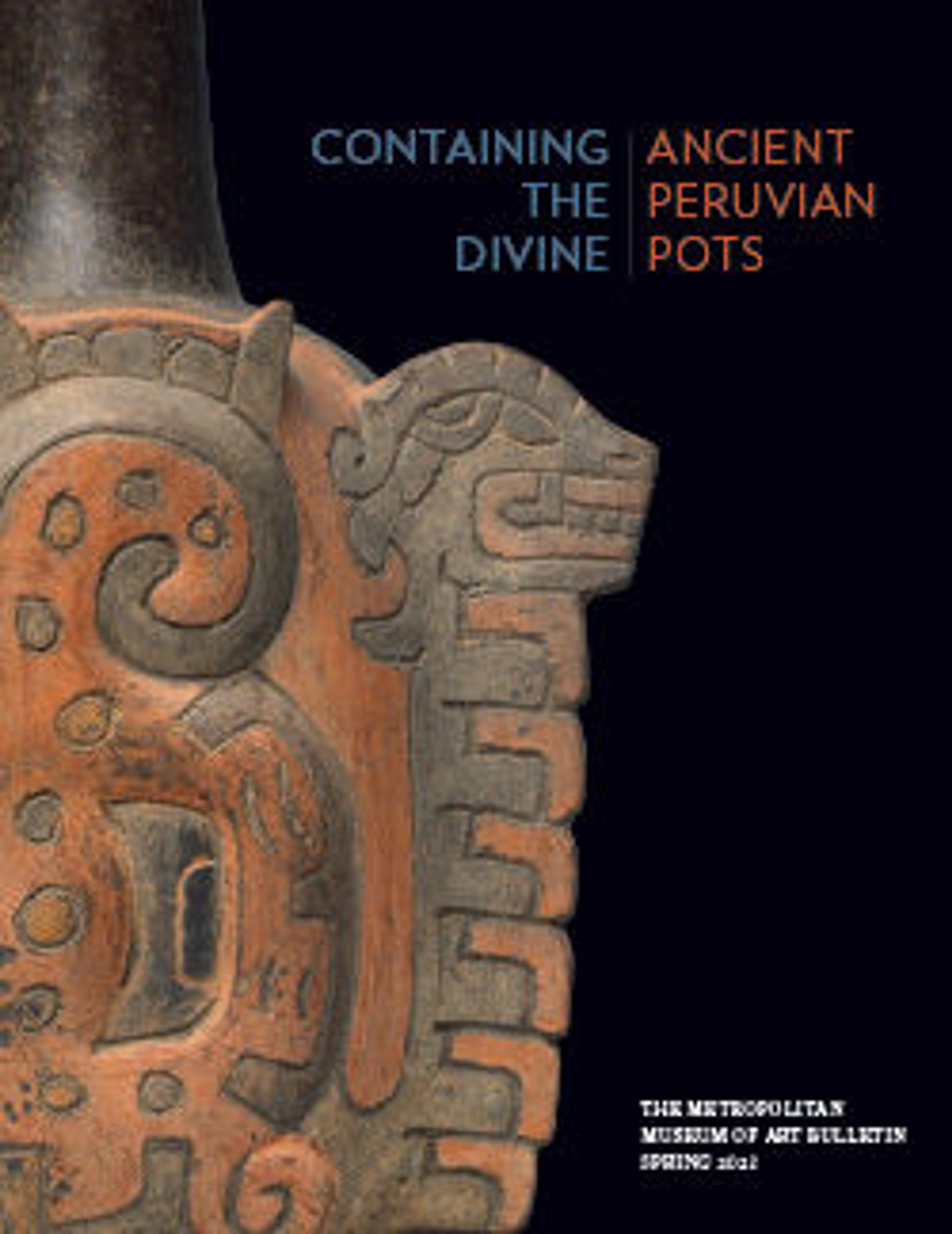Double-chambered bottle
This double-chambered spout-and-bridge bottle combines elements from Indigenous ceramic traditions with new materials and aesthetics that arrived with Spanish colonization. The shape of this vessel had a long tradition in the Andes, but this specific variation—with a wide handle and straight spouts—is a product of the hybrid ceramic style that emerged in the North Coast after the Inca conquest of the region in the fifteenth century (see MMA 64.228.54). The vessel bodies may represent two lúcumas (Pouteria lucuma), a fruit native to the temperate Andean valleys. This bottle generates sound when the vessel is tilted, and the chambers are partially filled with liquid, forcing air out and activating the bird-shaped whistle crowning one of the spouts.
The glossy surface was achieved with a lead-rich glaze, a silicaceous mixture containing lead oxides that vitrify on the surface during firing. The Spaniards brought Iberian ceramic kiln technology that is capable of reaching the very high temperatures needed for most of the glazes. A recent study, however, indicates that this kind of early green colonial glaze was often finished in open fires, a traditional and widespread Andean technology (VanValkenburgh et al. 2017). The lead acts as a flux that fuses below 800 C, a temperature within reach of Indigenous technology. The copper in the mixture produces green hues that have no precedent in Indigenous traditions of the Andes. Small differences in glazes’ recipes and firing conditions may explain color variation, such as this more yellowish example. The green-glazed ware was widely distributed during the early colonial era, but especially among Indigenous families who used them in their houses and sometimes put them in their graves.
Hugo C. Ikehara-Tsukayama, Senior Research Associate, Arts of the Ancient Americas, 2023
References and Further Reading
Hayashida, Frances. "Leyendo el registro arqueológico del dominio inka: Reflexiones desde la Costa Norte del Perú." Boletín de Arqueología PUCP No 7 (2004): 305-319.
Ikehara-Tsukayama Hugo C., Dawn Kriss, and Joanne Pillsbury. "Containing the Divine: Ancient Peruvian Pots." Metropolitan Museum of Art Bulletin vol. 80, no 4 (Spring 2023).
Stastny, Francisco. Las artes populares del Perú. Madrid: EDUBANCO, 1981.
VanValkenburgh, Parker, Sarah J. Kelloway, Karen L. Privat, Bill Sillar, and Jeffrey Quilter. "Rethinking Cultural Hybridity and Technological Transfer: SEM Microstructural Analysis of Lead Glazed Ceramics from Early Colonial Peru." Journal of Archaeological Science 82 (2017): 17-30.
The glossy surface was achieved with a lead-rich glaze, a silicaceous mixture containing lead oxides that vitrify on the surface during firing. The Spaniards brought Iberian ceramic kiln technology that is capable of reaching the very high temperatures needed for most of the glazes. A recent study, however, indicates that this kind of early green colonial glaze was often finished in open fires, a traditional and widespread Andean technology (VanValkenburgh et al. 2017). The lead acts as a flux that fuses below 800 C, a temperature within reach of Indigenous technology. The copper in the mixture produces green hues that have no precedent in Indigenous traditions of the Andes. Small differences in glazes’ recipes and firing conditions may explain color variation, such as this more yellowish example. The green-glazed ware was widely distributed during the early colonial era, but especially among Indigenous families who used them in their houses and sometimes put them in their graves.
Hugo C. Ikehara-Tsukayama, Senior Research Associate, Arts of the Ancient Americas, 2023
References and Further Reading
Hayashida, Frances. "Leyendo el registro arqueológico del dominio inka: Reflexiones desde la Costa Norte del Perú." Boletín de Arqueología PUCP No 7 (2004): 305-319.
Ikehara-Tsukayama Hugo C., Dawn Kriss, and Joanne Pillsbury. "Containing the Divine: Ancient Peruvian Pots." Metropolitan Museum of Art Bulletin vol. 80, no 4 (Spring 2023).
Stastny, Francisco. Las artes populares del Perú. Madrid: EDUBANCO, 1981.
VanValkenburgh, Parker, Sarah J. Kelloway, Karen L. Privat, Bill Sillar, and Jeffrey Quilter. "Rethinking Cultural Hybridity and Technological Transfer: SEM Microstructural Analysis of Lead Glazed Ceramics from Early Colonial Peru." Journal of Archaeological Science 82 (2017): 17-30.
Artwork Details
- Title:Double-chambered bottle
- Artist:Peruvian artist(s)
- Date:early 17th century
- Geography:Peru
- Culture:Viceregal Era
- Medium:Ceramic, glaze
- Dimensions:H. 5 1/2 in. (14 cm)
- Classification:Ceramics-Containers
- Credit Line:Museum Accession
- Object Number:X.2.292
- Curatorial Department: The Michael C. Rockefeller Wing
More Artwork
Research Resources
The Met provides unparalleled resources for research and welcomes an international community of students and scholars. The Met's Open Access API is where creators and researchers can connect to the The Met collection. Open Access data and public domain images are available for unrestricted commercial and noncommercial use without permission or fee.
To request images under copyright and other restrictions, please use this Image Request form.
Feedback
We continue to research and examine historical and cultural context for objects in The Met collection. If you have comments or questions about this object record, please contact us using the form below. The Museum looks forward to receiving your comments.
